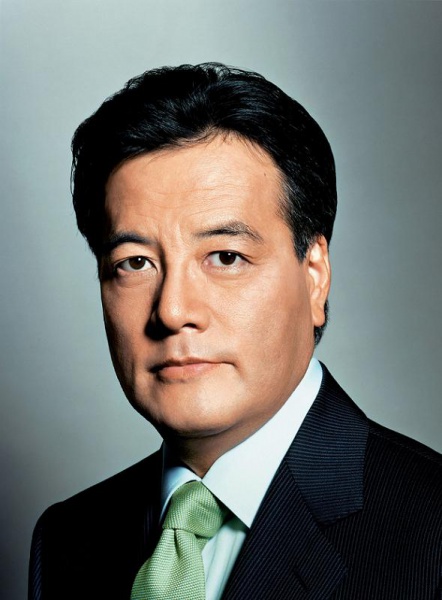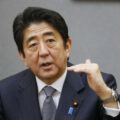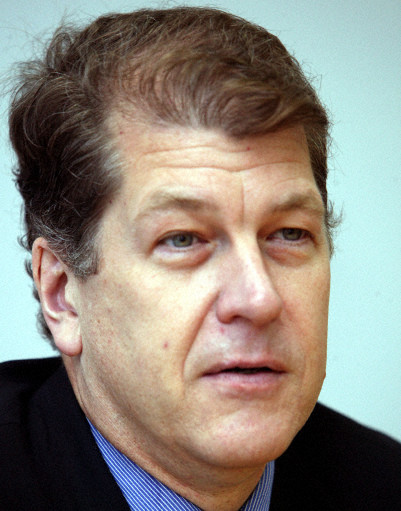Is “Reconciliation” Possible Beyond the Issue of Historical Recognition?
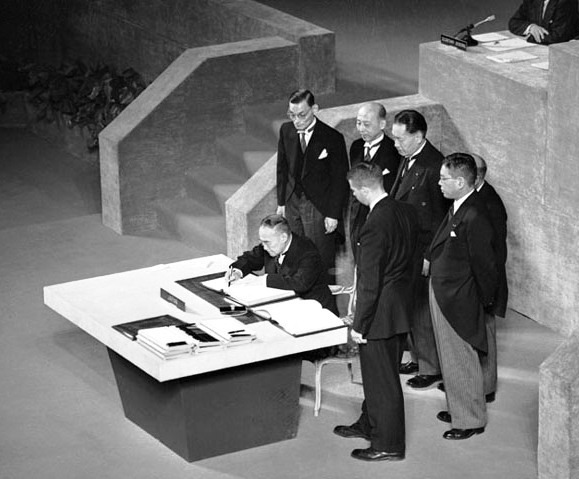
“Japan concluded the San Francisco Peace Treaty in 1951, which served as the basis for concluding bilateral peace treaties and reparation agreements with various neighboring countries including Russia and Southeast Asia. If we call this network of treaties the ‘San Francisco system,’ then the peace treaty system was based on a common principle.
Photo: Prime Minister Yoshida Shigeru (1878–1967) and the Japanese Plenipotentiaries signing the San Francisco Peace Treaty, public domain
Postwar Japan lacked a multifaceted and realistic “war theory.” In the 1990s, Japan was faced with the “history recognition problem” with China, South Korea, and other countries. Why has the problem become so complicated? How should we face the “Greater East Asia War” in the first place?
The real understanding of war that failed to develop in the shadow of “pacifism”
Fukuda Tsuneari (1912–1994), the late critic, once remarked, “The true collapse of Japan did not lie in its defeat, […] but rather began when it mistakenly believed that a new dawn would come by denying its own past.”
How to interpret the last war has been an important issue for postwar Japan. Looking back at the history of this debate, in the 1950s, the “aggressive war theory” and the “defensive war theory” were discussed in a binary opposition. At that time, the Tokyo War Crimes Tribunal (International Military Tribunal for the Far East), which was held from 1946 to 1948, had a strong influence. Among the defendants who appeared before the tribunal, three officials, Hirota Koki (1878–1948), Shigemitsu Mamoru (1887–1957), and Hiranuma Kiichiro (1867–1952), did not support the “theory of defensive war” proposed by lead defense lawyer Kiyose Ichiro (1884–1967). However, the academic community and the discussion circles did not question the meaning of the war, but rushed to assign responsibility for the war, and did not discuss essential issues such as “What was the meaning of the war” for the Japanese people?
Later, in the 1960s, the “theory of defensive war” was replaced by the “theory of war for liberation.” Among the leading commentators was Hayashi Fusao (writer, 1903–75), who attracted attention in 1963 when he published the “Affirmation Theory of the Greater East Asia War” in the monthly opinion magazine Chuokoron. The public discourse forums also began to discuss war theories centered on the “theory of aggressive war” and the “theory of war for liberation,” a trend that began in the 1970s and continued into the 1980s.
During this time, Japan’s theory of war was limited to dualism and did not become rich. The fundamental cause of this can be traced back to “pacifism[1],” a unique style of postwar Japan.
The term “peace-loving nation” was used as early as September 1945 in the Imperial Rescript at the opening ceremony of the first postwar Diet. Later, when the Japanese Constitution was enacted in November 1946, “pacifism” resonated with the cultural nation theory[2] and became a kind of national policy that permeated not only the public discourse forums but also Japanese society as a whole.
On the other hand, it has created a tendency to forget the last war as a “wrong war.” As a result, the Japanese people have not had a realistic understanding of the war. “Pacifism” expresses the determination to overcome the prewar system[3] and build a new postwar system, and it places more value on the break with these systems than on the continuity between the prewar, war, and postwar periods.
One of the reasons why “pacifism” spread so widely is that the Japanese people had a strong sense of victimhood due to their experiences with air raids, war damage, and the atomic bombing. Another factor may have been the reluctance of demobilized soldiers, especially those who returned from mainland China, to talk about their battlefield experiences. On the other hand, the collaborators of the Chinese Communist Army actively called for the war against China as an “invasion war,” but this did not spread throughout Japanese society.
It is regrettable that the Investigation Council for the War (then called the Investigation Council for the Greater East Asia War), established by the cabinet of Shidehara Kijuro (1872–1951) in November 1945, failed. The purpose of the Council was not to investigate responsibility for the war, but to investigate why Japan went to war and lost the war. It was a large-scale national project that brought together leading intellectuals, bureaucrats, and former military men of the time and aimed to examine and summarize the war from various perspectives, including economics and culture. The stenographic record shows, for example, that most of the questions that later became problematic regarding the causes of the war’s outbreak were already in place.
In September 1946, however, the activities of the Investigation Council were suspended at the request of the Soviet Union to the Allied powers. Nevertheless, if the government’s views had been expressed in some form, it would have provided a clue to the formation of the Japanese view of the war. There were voices calling for its continuation after the restoration of independence, but in the end there was no such movement, even after the San Francisco Peace Treaty (1951).
If this is the case, is it time for a national re-examination of the last war? There is currently no strong momentum in this regard. In recent years, the Democratic Party of Japan (1998–2016) has shown such a movement in the Diet, submitting many resolutions to pursue war crimes. On the other hand, the ruling party has continued to take a cautious stance when it comes to summarizing this war.
The “Greater East Asian War” was fought on four battlefields
Looking back on the last war is not an easy task today. Iriye Akira (Professor Emeritus at Harvard University) once pointed out that while a unilateral “national history” should not be rejected, in the age of advancing globalization, the history of a country is only meaningful if it is understood in the context of its relations and connections with other countries. Now that globalization is on the rise, this necessity is even greater.
Moreover, the nature of the last war was extremely complex. It is particularly noteworthy that the battlefields were divided into at least four. That is, the long war on the Chinese mainland, the war between Japan and the United States in the Pacific, the war in Southeast Asia, which was a colony of Europe including Britain, and the war with the Soviet Union before and after the end of the war. Moreover, these four battlefields were fought without necessarily being strategically related to each other, and the propositions and issues at stake regarding the purpose of the war were also different.
For Japan, the wars with China, the United States, and the Soviet Union were also struggles over the desirable order in their respective regions and wars for hegemony. On the other hand, the war in Southeast Asia was a struggle against colonialism and contained elements of a war of liberation. From Japan’s point of view, the immediate cause of the war was self-sufficiency and self-defense[4], but the number of enemies gradually increased, and self-sufficiency and self-defense alone no longer made sense.
However, as the Second Sino-Japanese War (1937–1945), then called the China Incident and a “war without a declaration of war,” dragged on, more and more regions chose not to fight Japan and tried to survive by cooperating with Japan, and they were strategically separated from the other battlefields. Why did this “incomplete war” eventually develop into the Greater East Asia War (1941–45)? One of the reasons there are so many different names for the last war is that there is no adequate explanation for it.
In any case, it is difficult to adequately describe the four battlefields, which had different characteristics and purposes, but it seems to me that the term “Greater East Asia War” that unites them all contains the complex meanings that the Japanese gave to the four battlefields.
Incidentally, although not directly related to the issue of historical consciousness, a common discussion about the last war is why Japan went to war with the United States, which was overwhelmingly stronger than Japan. In addition, the argument that it was a “foolish decision” is still made today. From today’s perspective, this is a correct point, but in fact the military at that time was well aware of the difference in national power.
When I was working at the National Institute for Defense Studies, I interviewed former Colonel Ishii Akiho (1900–96), who was attached to the Military Affairs Bureau of the Army Ministry until just before the outbreak of war. According to former Colonel Ishii, who negotiated with the Foreign Ministry as the army’s representative in the Japan-US negotiations just before the outbreak of war, he was fully aware of the difference in national power between Japan and the United States, but he did not think that this difference would directly determine the outcome of the war.
This was because he analyzed that the United States was a country of freedom and democracy and lacked the ability to mobilize its national power as it was and turn it into a fighting force. On the other hand, Japan at that time was an authoritarian state and was in an environment where it was easy to use its national power effectively. Therefore, Colonel Ishii thought that Japan could fight the US on an equal or better level. From today’s perspective, it is easy to point out the naivety of his understanding, but we should respect his judgment at that time.
Another major obstacle to negotiations with the United States before the outbreak of war was the demand for the complete withdrawal of Japanese troops from mainland China. At the time, the Japanese Army recognized that stationing troops in northern China was essential to prevent the spread of communism, especially in that region. Colonel Ishii thought that stationing troops would be useful not only for the defense of northern China but also for the defense of Manchuria and the Korean peninsula, and that the United States, which feared the communization of Asia, would understand. But this idea was not realized.
However, when the war actually ended, it was a historical fact that the Chinese Civil War (1945–49) broke out in mainland China and communism expanded. After the war, the view that the United States had liberated China from Japanese invasion, but that it was the Communists who benefited from it, gained some support in American academic communities. It can be said that Japan’s decision to maintain an anti-Communist garrison was not wrong. Looking at the last war from a broader perspective, Japan has been working hard since the Meiji Restoration (1868–69) to build a nation modeled on the West. This eventually led to a war with the West that was supposed to be its model, so there is no doubt that there are deep issues to consider.
After all, the Japanese at that time were probably trying to proactively create a new civilization, different from Western civilization, together with the people of Asia. Until then, Japan had gone to war with extremely limited objectives, whether it was the First Sino-Japanese War (1894–95), the Russo-Japanese War (1904–05) or the Mukden Incident (1931). But in the Greater East Asia War, Japan was driven by the feeling that Western civilization, which it had imitated in order to modernize, had aspects that did not fit Japan, or even Eastern civilization, and that it had been imposed on Japan. Wasn’t that why Japan and China were at the center of trying to create a new civilization and order?
Perhaps such thinking was never understood in China? In fact, around the time of the end of the war in 1945, there was a growing momentum for the Japanese military and the Nationalist government military to cooperate in order to counter Communist pressure. If Chiang Kai-shek’s government had gained a foothold on the mainland, perhaps some understanding would have been reached and the issue of “Japan-China historical reconciliation” would not have been so hotly debated.
The Murayama Statement and the Kan Statement were unique in world history
Although the situation has calmed down, it cannot be ruled out that controversies will erupt between Japan and South Korea in the future, such as the issue of former requisitioned laborers and the issue of comfort women.
Why did such a vexing problem arise in the first place? One reason is that the creation of a total mobilization system through the extreme mobilization of large numbers of people and goods from the late 1930s extended to the colonies. In particular, wartime requisition and the expansion of comfort women stations on the Korean peninsula caused many casualties. Another reason was that the defeat in the war and the abandonment of the colonies, that is, the dissolution of the empire, occurred at the same time. The two are basically separate issues, but in the case of Japan, the fact that it gave up its colonies at the same time as its defeat in the war complicated the issue.
Since war is a conflict between nations, it is natural for the defeated country to compensate for any damage or loss. However, the situation is different when it comes to the dissolution of a colony. Under the colonial system, the damage suffered by individuals cannot be resolved between nations, so it inevitably becomes a matter between the nation and the individual. As will be discussed later, this type of issue became apparent in the 1990s as the issue of postwar reparations.
Meanwhile, Japan concluded the San Francisco Peace Treaty in 1951 and, on the basis of it, concluded bilateral peace treaties and reparation agreements with neighboring countries including Russia and Southeast Asia. If we call this network of treaties the “San Francisco peace treaty system,” this peace treaty system was based on a common principle. It was the principle that claims for damages and losses caused by war should be mutually waived, not only by the state but also by individuals. It was a measure that could be said to have concentrated the damages and losses of individuals (citizens) caused by war in the hands of the state and dealt with them “in a lump sum.”
In this way, the peace system resolved the various problems caused by the war and curbed future problems, thus laying the foundation for the stability of the international order in the Asia-Pacific region. The framework of this peace system is said to have extended to the Agreement on the Settlement of Property and Claims and on Economic Cooperation between Japan and the Republic of Korea in 1965 and the Joint Communique of the Government of Japan and the Government of the People’s Republic of China in 1972, and remains in force to this day.
During this period, the Japanese government took the position in negotiations for the normalization of diplomatic relations with South Korea that there was no question of compensation or reparations because there was no state of war between Japan and South Korea. Negotiations became difficult when South Korea claimed to be one of the victorious nations, but after 15 years of negotiations, the Treaty on the Basic Relations between Japan and the Republic of Korea and other relevant agreements, as well as the Agreement on the Settlement of Problems Concerning Property and Claims and on Economic Cooperation between Japan and the Republic of Korea, were finally concluded in 1965. In short, with the establishment of the peace treaty system, it became impossible for individuals or nations to seek mutual compensation for damages caused by war and colonial rule. Not without reason, a Liberal Democratic Party (LDP) lawmaker boasted that this was “the result of efforts to avoid placing a financial burden on future generations.”
In the 1990s, however, there was a sharp increase in the number of cases brought to Japanese courts by individual victims from China and South Korea on issues such as comfort women and former requisitioned laborers. This is the so-called “postwar compensation issue.” The end of the Cold War, which had suppressed the emergence of such issues, and the LDP’s shaky control at home destabilized the stability of the peace system.
Another factor was that the winds of democratization began to blow through Asian countries in the late 1980s, and the voices of citizens and women’s groups grew louder in South Korea as well. Although democratization stalled in China, there was a time when the government could no longer ignore public opinion in the aftermath of the Tiananmen Square protests in 1989. In addition, this movement was driven by a trend toward respect for human rights and humanity, a trend toward “ethics in the international community.”
When the Miyazawa Kiichi Cabinet (November 1991–August 1993) was confronted with the issue of postwar compensation, it sought a new “history policy” based on a “moral” perspective rather than state compensation, while maintaining the framework of the peace system. Consideration of responsibility as an “economic superpower” also played a role. Later, during the Murayama Tomiichi administration (June 1994–January 1996), the Asian Women’s Fund (officially known as the Asian Peace and Friendship Foundation for Women), a semi-public, semi-private organization, was established to deal with the comfort women issue. The main pillars of the fund were a letter of apology from the prime minister and the payment of “compensation,” but this was not accepted by South Korea in particular. Proponents of national compensation in South Korea criticized the Asian Women’s Fund’s activities as obscuring who was responsible.
There are probably no cases in world history where a country has apologized for its colonial rule and made formal compensation. A similar discussion took place between France and Algeria during the presidency of François Hollande, but France did not agree to formal compensation. In addition, responses such as the Murayama Statement and the Kan Statement on the 100th anniversary of the annexation of Japan to Korea were unique in the context of world history. These can be seen as examples of Japan demonstrating sincerity before the rest of the world, but they can also be seen as the result of taking into account the fact that Imperial Japan’s war would not have been possible without the cooperation of the various ethnic groups in its colonies, which accounted for about 30% of its territory.
China’s view of history focuses on responsibility and results
The tricky thing about historical recognition issues is that they are now linked to territorial issues. There is the Senkaku Islands issue with China and the Takeshima Islands issue with Korea, and they now recognize these issues as issues related to Japan’s colonial rule and war of aggression. For example, the reconciliation framework of the landmark 1998 Japan-Republic of Korea Joint Declaration ceased to function when the Takeshima issue arose in 2005. From 2006 to 2009, I participated in the Japan-China Joint History Research, and I believe that the framework at that time was meaningful in terms of preventing historical issues from becoming diplomatic issues. It may not have led to a direct solution, but maintaining a platform for dialogue to jointly study and discuss history was expected to be effective in preventing the escalation of conflicts.
However, although the Japanese Foreign Ministry prepared to continue the joint historical research after that, the Chinese side did not agree. They were also very reluctant to publish the results of the research. As a result, no agreement was reached on the publication of the postwar part of the research.
It is my understanding that the Chinese side was particularly troubled by the description of the Tokyo War Crimes Tribunal. As a member of the Allied Powers (the victorious nations), it was impossible for the Chinese side to compromise on its position that the trial was a “just trial” that condemned the “war of aggression.” Another thing they were reluctant to make public was the interpretation of the Tiananmen Square incident.
Moreover, as far as China is concerned, there is no hope for improvement under the current Xi Jinping administration. In view of the current government’s policy on history, there is concern that the history of Japan-China relations will also be interpreted in terms of the history of the Chinese Communist Party, and that the history of the Sino-Japanese War as portrayed by Japan and China will diverge significantly. It must be remembered that the position of the leadership in China and South Korea also has a significant impact on the field of research.
The biggest difference between Japan, China, and Korea is the way they think about “history.” Especially in China, when talking about the wartime period since the 20th century, results are more important than anything else. For example, in the Nanjing Massacre of December 1937, the Japanese could argue that China bore some responsibility because Tang Shengzhi (1889–1970), the garrison commander of Nanjing, fled while calling for a fight to the death, but deserted his mission. The only thing that matters is the “result”—who was responsible for the repeated “massacres”—and this is at odds with the Japanese view, which emphasizes the process.
How should “reconciliation” be achieved?
I recently participated in a joint research project based at Waseda University on “Creation of Reconciliation Studies,” and the lesson I learned from it is that “reconciliation” is not a goal to be achieved, but rather a process that requires sustained efforts from both sides. In particular, “government-to-government reconciliation,” such as the normalization of diplomatic relations between Japan and the Republic of Korea (Treaty on Basic Relations between Japan and the Republic of Korea) and the normalization of diplomatic relations between Japan and China (Joint Communique of the Government of Japan and the Government of the People’s Republic of China), is nothing more than the product of political compromise and is far from reconciliation at the national level and is fragile. There is always the possibility that dissatisfied groups or individuals will avoid reaching an agreement. Indeed, issues of historical perception between Japan and China and Japan and Korea have yet to be resolved.
In order to ensure that reconciliation at the treaty (legal) level is firmly established at the national level, continuous efforts are required from both sides. This is why we believe it is necessary to form a sustainable platform that encourages two-way dialogue.
The issue of historical recognition is not a question of what the facts of the past were, but rather a question of how “we in the present” perceive the facts of the past. If this is the case, it seems that Japan-Korea relations today have reached a point where it is time to move away from a kind of obsession with victims and perpetrators.
For example, the historical friction between Japan and Korea is characterized by the fact that it is not caused by practical interests, but by problems in the recognition of past history. Conflicting interests can be reconciled or compromised, but it is important to change the way we understand the colonial past and create a common basis for recognition in order to close the gap in historical recognition. If prewar Japan was the only non-Western country to succeed in modernization, then Korea is an exception among countries that experienced colonialism and achieved success in political and economic development. It seems necessary to first position both countries internationally. On this basis, imagining a future that both can share will be the foundation for building Japan-Korea relations.
On the occasion of the 70th anniversary of the end of the war (2015), Emperor Akihito (now Emperor Emeritus) made the following statement based on his visit to Palau in April of that year:
“With each passing year, we will have more and more Japanese who have never experienced war, but I believe having thorough knowledge about the last war and deepening our thoughts about the war is most important for the future of Japan.”
How seriously have the Japanese considered this question? The reason I insist on using the term “Greater East Asia War” is that I recognize its significance as a “pathway,” so to speak, for passing on to future generations the various realities of the war, including its large-scale mobilization that produced requisitioned laborers and comfort women and other “negative legacies.”
This “pathway” can also be a “pathway” for considering what we as a nation should reflect upon and what we should inherit or commemorate.
Moderated by Mizushima Ryusuke, PHP Institute
Translated from “Tokushu Sengo 79-nenmeno Shukudai: Rekishininshiki Mondai no Sakini ‘Wakai’ wa Aruka (Feature: Homework 79 years after the war: Is “Reconciliation” Possible Beyond the Issue of Historical Recognition?),” Voice, September 2024, pp. 76–85. (Courtesy of PHP Institute) [October 2024]
[1] Pacifism is an ideology that seeks to resolve conflicts and build international relations through diplomacy, dialogue, and international cooperation, rather than relying on war or military force.
[2] The “cultural nation theory” is a postwar Japanese idea that aims to build a nation based on cultural power rather than military might. After World War II, Japan decided to renounce war and become a non-militaristic nation under Article 9 of the Constitution, and was expected to contribute to the international community through culture.
[3] The “prewar system” refers to the system in which a ruling system colored by imperial sovereignty, militarism, and State Shinto was firmly established under the Constitution of the Empire of Japan.
[4] Self-existence and self-defense was set by Japan in 1941 as one of its goals in the Greater East Asia War, along with “building a new order in Greater East Asia (Greater East Asia Co-Prosperity Sphere),” and referred to a nation that maintains its existence and defends itself by its own efforts.
Keywords
- Hatano Sumio
- Japan Center for Asian Historical Records
- University of Tsukuba
- reconciliation
- history recognition
- war theory
- China
- South Korea
- United States
- Great East Asia War
- Sino-Japanese War
- Russo-Japanese War
- World War II
- pacifism
- Investigation Council for the War
- Murayama Statement
- Kan Statement
- postwar compensation issue
- Japan-China Joint History Research
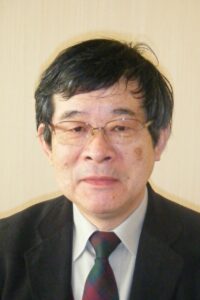 HATANO Sumio, Ph.D.
HATANO Sumio, Ph.D.
